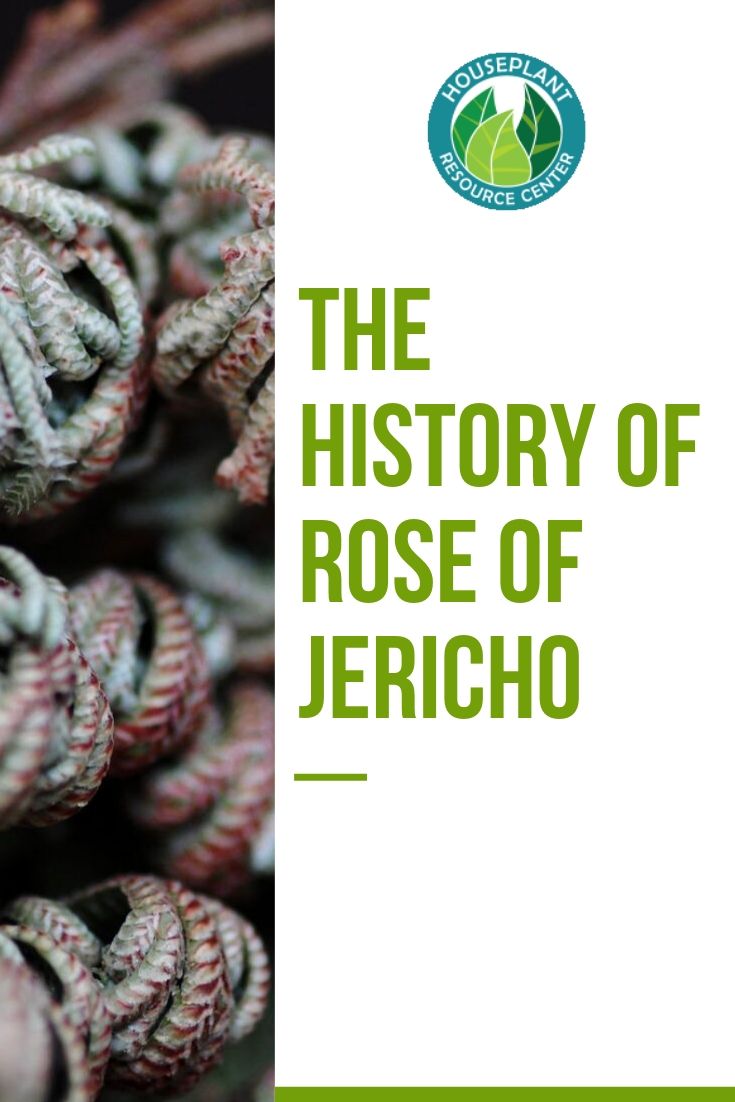The Rose of Jericho, or resurrection plant, might have more mystique than any other houseplant. After all, what other plants can dry out completely and “die,” and then come back to life after a few hours in water? It’s like magic!
This plant (both true and false Rose of Jericho) have a long, rich history in literature, religion, and medicine.
We love learning about the history of our houseplants because they take on a new meaning for us when we know what meaning they hold in different cultures around the world.
Let’s learn about Rose of Jericho!
A Plant of Many Names
First, keep in mind that when we say “Rose of Jericho,” we may actually be referring to two different plants. These plants are also called resurrection plants, and that term could actually refer to about 130 different plants with the ability to dry out and come back to life.
In this article (and on this site), we mainly talk about two forms of the Rose of Jericho/resurrection plant:
First, there’s the “true” Rose of Jericho called Anastatica heirochuntica. This plant comes from northeast Africa and the Middle East (i.e., Jericho) and is actually really hard to find.
This plant grows little white flowers when fully hydrated, but it must actually root in soil to revive. It’s the only plant in the Anastatica genus and is a member of the mustard family.
The second plant that carries the name “Rose of Jericho” is Selaginella lepidophylla, or false Rose of Jericho, or dinosaur plant. This plant comes from the Chihuahuan desert of Mexico, New Mexico, and Arizona.
Like the true Rose of Jericho, this plant also dries up completely and blows around until it finds a puddle where it can get a drink and revives itself.
This plant is much easier to find than the true Rose of Jericho, which is fine by us because it’s also a lot more affordable, attractive, and easy to care for. Unlike the true Rose of Jericho, false Rose of Jericho can revive whether its roots are planted or not. All it needs is water!
Selaginella lepidophylla, the one we talk about most around here, is actually a spike moss! Isn’t it cool how two completely different plants have evolved with such similar adaptations?
Rose of Jericho Around the World
Religion and Literature
Resurrection plants are powerful metaphors for life, love, and rebirth, and it’s no surprise that they pop up in poems and novels from time to time. Resurrection plants appear in poems such as “To the Duke of York” by Robert Herrick, Christina Georgina Rossetti’s “A Rose Plant in Jericho,” and Mollie Moore’s “The Resurrection Plant,” to name just a few.
And the metaphors don’t stop there. Understandably, this plant symbolizes resurrection, rebirth, enduring love, and longevity in many world religions including Hoodoo, Wicca, Santeria, Yoruba, Catholicism, and many others.
In many of these traditions, Rose of Jericho is said to call in wealth, provide protection, bring good luck, and absorb negative energy. It’s sometimes used in spells to “resurrect” an aspect of a person’s life such as romance or income.
For example, Hoodoo practitioners use this plant in prosperity spells by adding five coins to the water used to revive the plant. They then brush the water onto windows and doors to invite prosperity into their homes.
In the Cuban Santeria religion, Rose of Jericho is often used as a spiritual offering.
Rose of Jericho is also popular in Christianity as a Christmas and Easter decoration because it symbolizes the resurrection of Christ. Spanish missionaries even used Selaginella lepidophylla to teach Christian concepts to Native Americans.
Around the world, many families cherish their Rose of Jericho plant and pass it down through generations!
Medicine and Science
Rose of Jericho (and resurrection plants in general) are unusual plants, so naturally, they attract a lot of attention from the scientific community.
Scientists around the world study these plants to better understand their drought-resistant properties, which could possibly lead to more drought-resistant crops and a more sustainable agricultural system.
Rose of Jericho is also no stranger to medical traditions. Traditional Egyptian medicine uses Anastatica heirochuntica to treat fatigue and uterine hemorrhaging. In Mexico, Selaginella lepidophylla is used to quicken labor, and the speed of the plant’s revival is sometimes used to predict the outcome of childbirth.
False Rose of Jericho is sometimes used to treat colds and sore throats in herbal medicine, and the plant is currently being studied for its antioxidant and anti-cancer properties. This plant gets around!
We can’t think of another humble houseplant with such a wide history in so many different areas of human achievement. And it’s so easy to care for!
If you’re ready to bring home your very own Rose of Jericho and watch the magic unfold for yourself, check out our care guide for this hardy and fascinating plant!
Houseplant Essentials:
- Make sure you’re giving your plants the right nutrients! Our Indoor Plant Food works perfectly for almost all indoor plants, and it’s easy to use. Grab it here!
- Use our premium well-draining potting soil for your houseplant.
- Protect your houseplant from insects, bacteria, and fungus with our Houseplant Leaf Armor. (As an added bonus, the Leaf Armor also cleans and adds shine to your houseplant’s leaves!)
- Use a moisture meter like this one to always know how thirsty your plant is.
To learn more:
- Join us for our free Top Secrets From Fiddle Leaf Fig Growers Webinar or enroll in our free Advanced Fiddle Leaf Fig Care Course.
- Read The Fiddle Leaf Fig Expert, your complete guide to growing healthy fiddle leaf fig plants. The book is available in full-color paperback or Kindle edition on Amazon now!
- Click to join our community on Facebook: Fiddle Leaf Fig Plant Resource Group.




